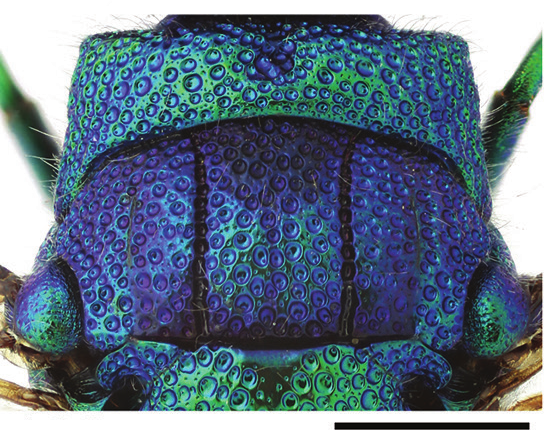Chrysis clarinicollis
- Innhold
- Diagnosis
- Distribution
- Biology
Diagnosis
Figure 98
Metasoma, dorsal view: C. clarinicollis ♀. Scale 1 mm.
Figure 162
Pronotum and mesoscutum, dorsal view (arrow indicating lateral field of mesoscutum): C. clarinicollis ♀. Scale 1 mm.
Length 6–10 mm.
The species is characterised by a uniformly green or bluegreen pronotum and mesoscutellum, and a contrastingly darker blue or violet mesoscutum (Fig. 162). The tergites are mainly golden red, but T1 is anteriorly and laterally blue-green or green (Fig. 98). Shape of the metasoma is broad and compact (Fig. 98). Punctation of T2 is somewhat finer than on T1 and dense throughout (Fig. 98). The sternites and legs are ventrally greenish. The apical rim of T3 is narrow and the intervals of the apical teeth very shallow (Fig. 98). The mandible and ovipositor are thin (as in Figs 92 and 141). Males in particular can be confused with other species of the C. ignita group as their colouration is more variable than in females. The colouration should always be used in combination with other characters (e.g. shape of metasoma and apical teeth) in species identification.
Distribution
Estonia. Very rare. Only four records are known from Estonia, all from the western part of the country (Ahu, Manilaid, Tuudi, Väike-Pakri; 2001–2009).
West Palearctic: southern and central Europe, northern Africa (Linsenmaier 1997).
Biology
Habitat: forest margins, clearings and gardens with sun-exposed dead wood. Usually observed on dead tree trunks and on walls of abandoned houses (Rosa 2006), but also flying near the ground and over rocks (Linsenmaier 1997).
Flight period: June to August. The earliest Estonian specimens were collected in the beginning of June and the latest in the end of July.
Host: possibly Ancistrocerus oviventris (Wesmael) and/or A. scoticus (Curtis) (Vespidae) (Petit 1987).

